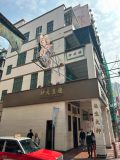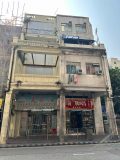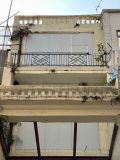Linyong Xia (3035951923)
Chang Liu (3035952197)
Linyong: In early February, we had a field trip on Shanghai Street, that’s really a historical road that even brought me back to the old time Hong Kong.
Chang: Yes, Shanghai Street is a famous historical street in Hong Kong. At the end of the 19th century, Hong Kong as a flourishing port city attracted many merchants from all over the world, and Shanghai Street became one of the earliest commercial centers in Hong Kong. Have you noticed that the buildings on Shanghai Street are quite aged?
Linyong: Yes, this historical background leads to the existence of more than 30 shops that have been in business for more than 40 years and several century-old shops on Shanghai Street. Speaking of these old buildings, there are three major periods of construction on Shanghai Street: the 19th century, brick and timber buildings; and the early 20th century, the “transitional” shophouses built mainly of brick, timber and reinforced concrete; and finally the buildings of the late 1920s and 1930s, which were constructed entirely of reinforced concrete.
Chang: That’s interesting. Actually at the first time walking on Shanghai Street, they all seemed like the “old buildings” to me. After the field trip, I had a detailed research on Tong Lau, which is one of the characteristic constructions on Shanghai Street. Tong Lau is a Cantonese pronunciation and it means “Chinese building”. Tong refers to the Tang dynasty and is used as a term to mean Chinese, and Lau is a building with more than one floor. Tong Lau are tenement buildings built from the late 19th century to the 1960s in Hong Kong, Taiwan, Southern China and Southeast Asia. They are designed for both residential and commercial use.
Linyong: I also found that Over the years, Tong Lau construction has seen influences of Edwardian-style architecture and later the Bauhaus-movements. And every places’ Tong Lau has their own strong local characteristics, like Singapore, Singapore has the ‘Singapore Shophouses with five-foot ways’, while Guangzhou has ‘Guangzhou Veranda’.
Chang: An interesting thing is that Tong Lau has a very loose definition under the context of Hong Kong. In Hong Kong’s building regulations, Tong Lau refers to a building with any living space intended for more than one tenant. The ground floor is basically reserved for commercial use, mostly by small businesses like retail shops and food vendors. The upper floors are for residential use, and cater to Chinese residents of Hong Kong. The most representative style of Tong Lau in Hong Kong is the veranda, or most times just directly concluded to “Guangzhou Veranda”. However, there has no clear conclusion from the architectural historian that whether it really came from Guangzhou. I’ve noticed that there’re two Tong Lau quite antique on Shanghai Street, right?
Linyong: Yeah, there’re two most famous and historical Tong Lau on Shanghai Street. Let’s have a look at the picture.
Chang: Ok, this is 176-178 on Shanghai Street. We can see that a big sign of ‘1940’ on the top of the arch, which represents the building was constructed in 1940. At present, it turns to a whole building of Tak Sang Pawn Shop. On each of the floor, the balconies are equipped with security bars, I guess they’re used for preventing the thieves, which is really common in the low height buildings.
Linyong: And This is 313-315 on Shanghai Street. Built in 1925, almost already 100 years, it even has a longer history than the previous one. As we can see in the picture, this is a four-storey tenement, and the stores below write their names on the Roman concrete pillars on the ground. An interesting thing is that, in 2014, a van was out of control and crashed into the tenement, the van was damaged but the pillars were intact, which can see how strong they are.
Chang: That’s … amazing. Since Tong Lau is such a historical and characteristic architecture in Hong Kong, why they are likely going to vanish in ten years?
Linyong: Due to the long-time disrepair, those aged Tong Lau are likely the first to go under the government’s redevelopment plans. The redevelopment projects in Yau Ma Tei and Mong Kok these two districts have comprised more than 3,000 buildings, and 47 percent of which are older than 50 years old and in poor condition. Many of these buildings, including Tong Lau, could be demolished for not meeting structural safety. Furthermore, since tackling housing shortage and to expediting redevelopment have been point out in the policy address by Chief Executive John Lee, more and more aged Tong Lau may face a demolishment.
Chang: Oh that’s quite pity to lose those witness of Hong Kong history, is there any possibility to preserve?
Linyong: Yes, there indeed has a way to balance development and preservation. Aged Tong Lau can be refurbished into a modern style instead of making way of new structures. But it’s not a simple process. The Tong Lau built in 1940 on Shanghai Street, which you introduced earlier, is an example. Also, Tai Wo Tang Café is a successful transformation from an 80 years old Tong Lau in Kowloon City. The founder said he took great pains to navigate structural maintenance issues and licensing requirements to preserve some of the building’s old fittings and furniture.
Chang: I’m curious what’s the attitude of the residents living in these Tong Lau, will their life be affected?
Linyong: Actually, as a conservation advocate said, his efforts were not always welcomed. He thought that “The last generation of owners, they usually assess the building from its economic value only. They rather prefer selling the tong lau to gain great profit and invest in some other business”. But it’s one side, in my view, conservation of course very important, but we should also consider the feelings of residents living in the aged Tong Lau. The infrastructure of Tong Lau is out of modern living standard and is too shabby for people to live.
Chang: Yeah, with the development of the times, redevelopment and renovation of old buildings are inevitable, but I hope to preserve the style of the old buildings and retain that retro texture of light and shadow, so that every visitor to Shanghai Street in the future will be able to experience the path of Hong Kong’s history. So well-planned reconstruction may be the best way not only keeping the historical value, but also be able to promote the living standard.
* As we recorded our dialogue in zoom, some sentences may sound fuzzy. But our transcript contains the main context of our dialogue.




